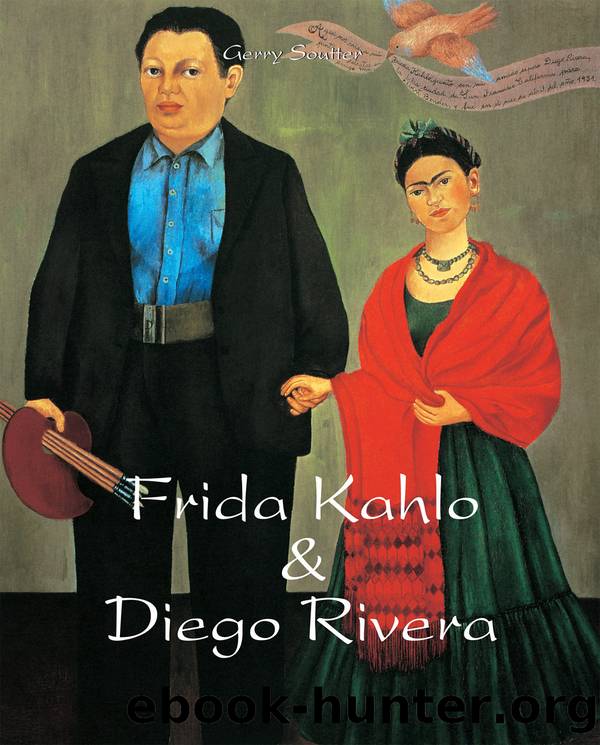Frida Kahlo & Diego Rivera by Gerry Souter

Author:Gerry Souter [Souter, Gerry]
Language: eng
Format: epub
ISBN: 9781644617779
Publisher: Parkstone International
Diego Rivera, Portrait of the Poet Lalane, 1936. Oil on canvas. Private collection.
Diego Rivera, Portrait of a Military Man, date unknown. Museo Regional de Guadalajara, Jalisco.
Chicharroâs reports to Don Dehesa, Governor of Veracruz and Diegoâs sponsor, were glowing and the paintings regularly sent to Dehesa reflected the reportsâ praise. Some of Chicharroâs student exhibitions drew critics who singled out Rivera as a âpromising talentâ. Diegoâs brush with the Madrid avant-garde found him embroiled in an anti-modern art movement (el MuseÃsmo) which demanded the abandonment of modern art for the 300-year-old El Grecos. Hardly a plunge into the future, but Riveraâs painting during his isolated two years in Spain was conventional, slick and bland.
While Picasso was creating the revolutionary Les Demoiselles dâ Avignon, Rivera ground out The Forge, The Old Stone, New Flowers, and The Fishing Boat. The paintings were handsome if only because of their superb technique, but they would also have looked at home in any mercado tourist shop. To be charitable, Rivera did manage to keep his meal ticket coming from the Governor of Veracruz. And he met a girl.
At the Café de Pombo, a hang-out for the Spanish avant-garde, Diego spent time with the two Ramóns and MarÃa Blanchard. Ramón number one was Ramón Gómez de la Serna, a critic and soon-to-be Dada poet. Ramón number two was Ramón del Valle-Inclán, a Spanish novelist who had lost his left arm to the swing of a cane in a brutal café brawl. He was a grand storyteller, and Diego thoroughly absorbed his enthralling gift of prevarication, adding touches to expand his own myth-making machine. MarÃa Blanchardâs real name was MarÃa Gutiérrez Cueto, and she was one of Chicharroâs painting students. She was bright, five years older than Diego and four feet tall with a subtle hunchback caused by an accident to her spine in her youth. She dressed in the English tourist style and made a striking contrast to her towering mountain of a friend (and lover, according to Rivera in later years). In 1908 she headed for Paris, leaving Diego to finish up his second year in Spain. He prowled the Basque countryside looking for material, and entered some of his paintings in another exhibition where his friend Ramón Gómez de la Serna gave him a booster review.
The bohemian lifestyle of this merry band eventually laid Diego low, so he stopped drinking and went on a vegetarian diet â a purge he resorted to again later in his life. He took hikes and began reading very serious books: Aldous Huxley, Emile Zola, Arthur Schopenhauer, Friedrich Nietzsche, Charles Darwin, Voltaire and Karl Marx. He devoured books on mathematics, biology and history, drowning his over-indulged body with intellectual stimulation.
After sticking it out for two years, Chicharro, Ramón Valle-Inclan and Rivera, apparently flush with winnings gathered from a Spanish casino, took a train to Paris, chipped in for a horse cab to the Place Saint-Michel and found rooms at number 31, the Hotel de Suez on the Boulevard Saint-Michel. This
Download
This site does not store any files on its server. We only index and link to content provided by other sites. Please contact the content providers to delete copyright contents if any and email us, we'll remove relevant links or contents immediately.
The Japanese by Christopher Harding(1017)
Watercolor With Me in the Forest by Dana Fox(716)
A Theory of Narrative Drawing by Simon Grennan(706)
The Story of the Scrolls by The Story of the Scrolls; the M(695)
Glittering Images: A Journey Through Art From Egypt to Star Wars by Camille Paglia(618)
Boris Johnson by Tom Bower(590)
The Art and Science of Drawing by Brent Eviston(564)
This Is Modern Art by Kevin Coval(562)
Frida Kahlo by Frida Kahlo & Hayden Herrera(552)
AP Art History by John B. Nici(538)
Banksy by Will Ellsworth-Jones(533)
War Paint by Woodhead Lindy(518)
Van Gogh by Gregory White Smith(515)
Scenes From a Revolution by Mark Harris(510)
Draw More Furries by Jared Hodges(508)
Ecstasy by Eisner.;(501)
About Looking by John Berger(498)
100 Greatest Country Artists by Hal Leonard Corp(496)
Young Rembrandt: A Biography by Onno Blom(486)
